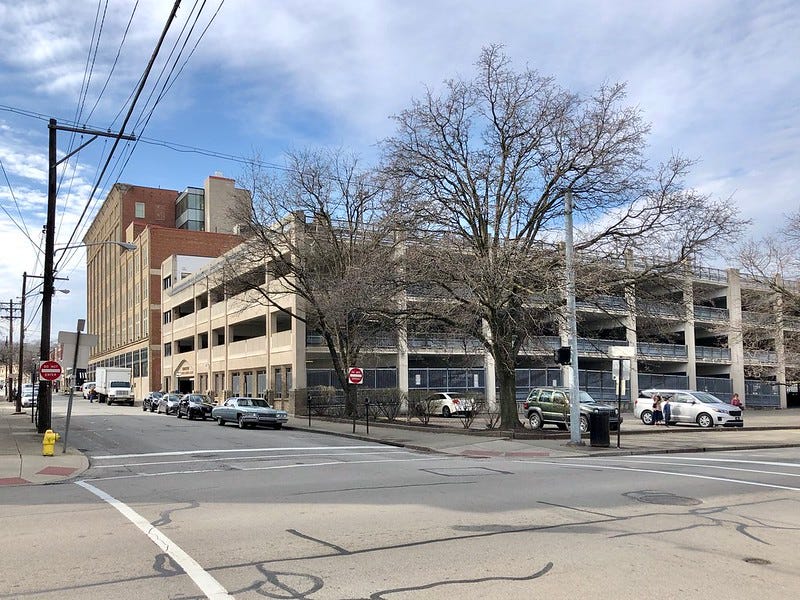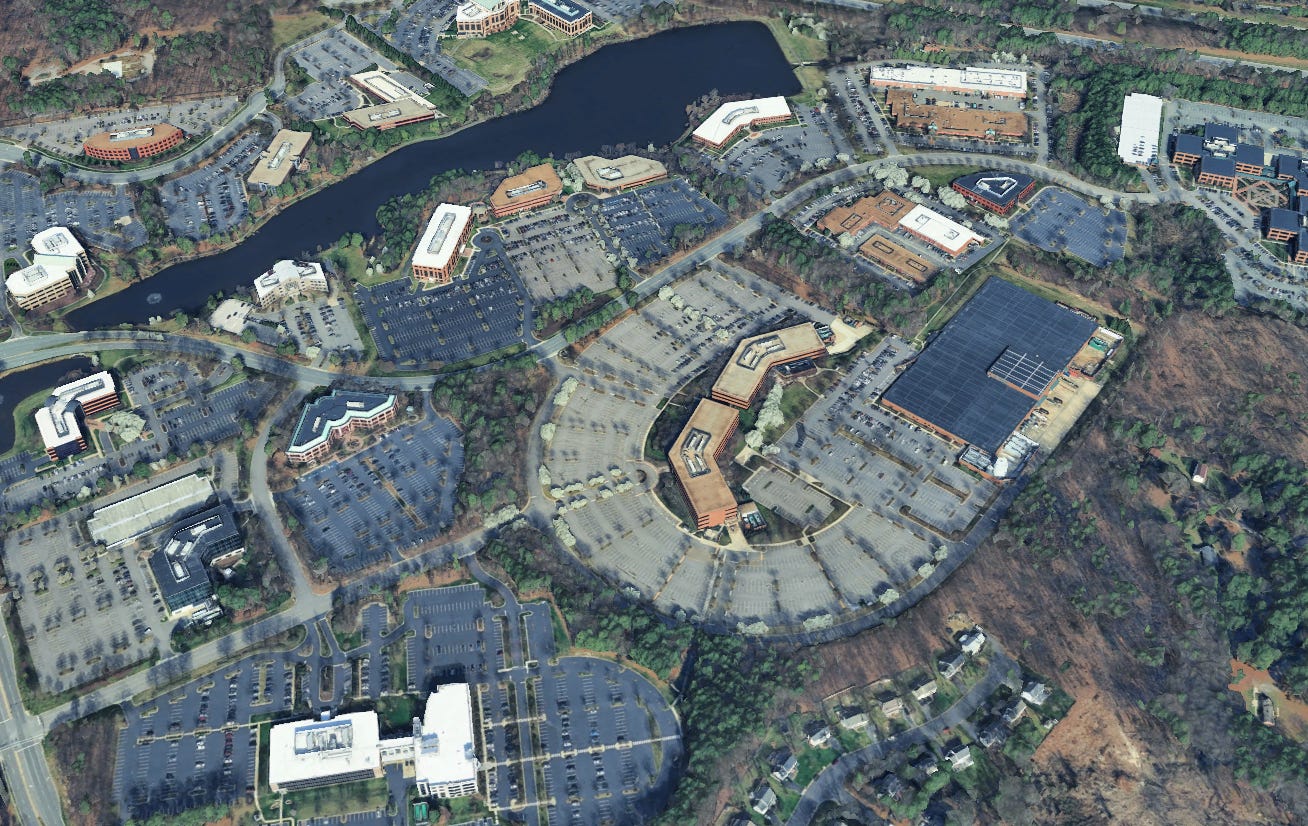With my mind on my money and my money on my parking reform
A tribute to Donald Shoup Dogg, the pied piper of parking
Considering the huge impact that car storage has on the built environment, I’m surprised I’ve only written specifically about it a few times. Last week, Donald Shoup, author of The High Cost of Free Parking, passed away at age 86.
In the US, we’re accustomed to thinking of parking as a basic convenience—something that should be widely available and, of course, free. But as Donald Shoup famously argued in The High Cost of Free Parking, parking is never truly free. Its costs are hidden in higher rents, more expensive goods and services, and lost economic potential.
Local governments have long mandated parking minimums for businesses, apartment buildings, and offices, requiring developers to provide a certain number of parking spaces—regardless of actual demand. Ballpark estimates are 25% of American cities are dedicated to car storage. That’s a massive economic burden that affects everyone, even those who don’t drive.
Here’s how “free” parking makes everything more expensive and what cities can do to fix the problem.
One of the most significant but least recognized economic costs of free parking is its impact on housing. Parking spaces are expensive to build: $25,000 – $60,000 for structured parking and $100,000+ for underground parking. Developers do not absorb these costs. They pass them on to tenants and buyers in the form of higher rents and home prices. Even if you don’t own a car, you’re still paying for that parking space because the cost is bundled into your rent or mortgage.
A study from UCLA found that in cities with strict parking mandates, the requirement to provide parking:
Increased rents by up to 17%.
Reduced the number of affordable housing units built.
Made small-scale, low-cost housing (e.g. accessory dwelling units) economically unfeasible.
By eliminating parking minimums, cities can allow developers to build what the market actually demands, lowering housing costs for everyone.
Businesses don’t provide free parking out of generosity. Whether it’s a grocery store, shopping mall, or restaurant, the cost of maintaining parking lots is embedded in the prices customers pay.
Large surface parking lots require constant repaving, lighting, security, and drainage infrastructure—all of which increase operational expenses.
Many businesses lease their spaces, and landlords factor the cost of required parking into rent. That rent gets passed down to customers through higher prices.
A single shopping mall parking space can cost $5,000 to $10,000 to build. The cost doesn’t disappear—it’s simply built into the price of every item sold in the stores. The result? Even if you walk, bike, or take transit to the store, you’re still paying for the parking spaces you don’t use.
Many employers offer free parking to employees, a benefit that seems costless but is anything but. Studies show that employer-provided parking is:
A hidden subsidy for driving worth hundreds of dollars per employee per month.
A major contributor to congestion and increased commuting times.
A missed opportunity for salary increases or transit benefits.
Donald Shoup highlighted how parking cash-out programs (where employees can choose between a parking space or its cash equivalent) led to a:
11% drop in solo car commuting.
64% increase in carpooling.
50% increase in transit use.
Forcing employers to provide parking limits their flexibility to offer better benefits, such as transit passes, remote work stipends, or even higher wages.
Parking requirements waste prime urban land that could otherwise be used for housing, businesses, or public spaces. A single parking space takes up more land than a studio apartment. Surface parking often occupies more land than the buildings it serves.And in many cities, more land is dedicated to parking than to actual housing.
This has major economic consequences:
✅ Higher commercial rents because available land is artificially restricted.
✅ Lower tax revenues for cities, since parking lots generate far less property tax than buildings.
✅ Fewer jobs and economic activity, as businesses are forced to spread out rather than cluster together.
In so many of America’s dense, walkable areas, huge chunks of land are dedicated to car storage. That’s land that could be generating tax revenue, providing housing, or supporting businesses.
Parking Benefit Districts
One of Donald Shoup’s key proposals to address these economic distortions is the Parking Benefit District. Instead of subsidizing free parking, cities can:
Charge market-based prices for street parking (adjusted based on demand).
Use the revenue to directly improve the surrounding neighborhood (funding things like sidewalks, transit, street trees, or public safety).
It’s a fantastic story framing, because everyone wants perks. Rather than presenting parking as something you have to pay for, position the residents and business owners as recipients of parking revenue. I think the reason I most love Shoup’s idea is that it’s a rare opportunity for people across the political spectrum to wholeheartedly agree on something. An anti-car extremist and a pro-car extremist who live on the same block can agree that it’s in their best interest for motorists to pay for car storage in their Parking Benefit District.
In California’s state capital, the Old Pasadena district was struggling with empty storefronts, low foot traffic, and declining property values. After creating a Parking Benefit District in 1993:
✅ Demand-based parking pricing reduced congestion from drivers circling for parking.
✅ 100% of parking revenue funded local improvements like sidewalk repairs, better lighting, and landscaping.
✅ Business activity surged, making Old Pasadena one of the most successful retail districts in California.
Cities that implement Parking Benefit Districts turn parking revenue into local investment, rather than subsidizing car storage at the public’s expense.
💰 Higher rent and home prices
🛒 More expensive goods and services
📉 Lower wages and lost productivity
🏗️ Wasted land that could be economically productive
By eliminating the mandates to build more car storage, implementing demand-based pricing, and using Parking Benefit Districts, local governments can lower costs, boost economic growth, and improve quality of life for everyone—drivers and non-drivers alike. It’s time to stop pretending free parking is free.






Donald Shoup Dogg sounds like the Jane Jacobs (or Jeff Speck) of parking. I love the idea of parking benefit districts as you describe it here.
I am an unapologetic Shoupista, but there's something I would like to point out for the sake of expanding outreach. "Parking is never really free" is true of all goods and services, including some that are uncontroversial public goods. Municipal buildings, parks, streets, and sidewalks are not free in that sense, either, and nobody is writing a book titled, "The High Cost of Free Municipal Buildings." Much like induced demand, we should be aware that "The High Cost of Free Parking" is a normative theory and this is not lost on those whom we are attempting to convert. In the cases of induced demand and free parking, the status quo is imagining car infrastructure as a public good and our burden is convincing them that car infra is not a public good.